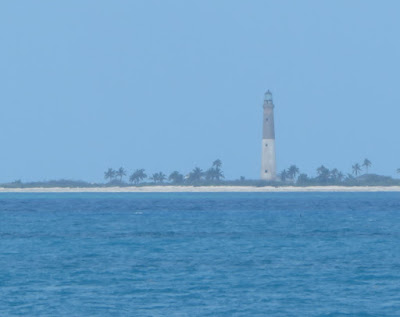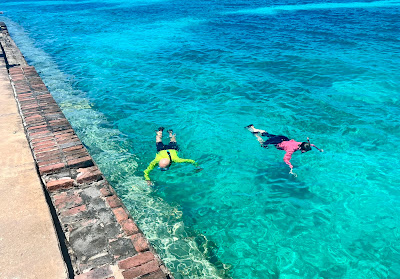 |
| Approaching Fort Jefferson |
7 tiny coral and sand keys 69 miles west of Key West, sitting
by themselves at the entrance to the Gulf of Mexico were considered to be of
such strategic importance that in 1846 the US Army started building what would
become the largest brick structure in North America, Fort Jefferson. Today, that fort and the surrounding keys and
waters are protected as the Dry Tortugas National Park.
 |
| Fish swimming outside the outer wall of the fort |
We went to tour Fort Jefferson and to snorkel in the ocean
waters along the outside of the fort to see the creatures that have taken up
residence in the crevices along the masonry structure.
 |
| Fort Jefferson lighthouse |
The Dry Tortugas were named "Los Tortugas" by the Spanish explorer Ponce
De Leon who marked them on the nautical chart as being a location where mariners could
find an important food source, green sea turtles.
Subsequent mariners added “Dry” to the name, because none of the keys
have a source of fresh water.
 |
| Lighthouse built on Loggerhead Key in 1857 |
These keys are at the end of a curved coral reef that extends south and west from Miami. Ships sailing into or out of the Gulf of Mexico had to sail around them to avoid hitting the submerged reefs and sinking. Also, the powerful Gulf Stream flows nearby that mariners used to assist them as they traveled up the East Coast and over to Europe. Ships carrying goods that came down the Mississippi River to New Orleans for markets on the East Coast or Europe sailed right by these keys. Also, ships bringing goods into New Orleans sailed past them as well. They were a very strategic location.
 |
| The Sally Port is the only entrance/exit to the fort |
The Dry Tortugas also provided natural deepwater harbors surrounded by shoals that US military ships patrolling these important shipping lanes could use to get supplies, make repairs or seek refuge during storms.
 |
| So many bricks |
The army started building the enormous (16-acre) Fort
Jefferson in 1846. Everything that they needed
to construct the fort had to be brought in by sailing vessel. All that was there was saltwater, sand, coral
and a few scrub trees. Imagine the
logistics of importing the 16 million bricks that were used, not to mention the
special stone floors that withstood the force of cannons firing, or the
cannons themselves.
 |
| Imagine unloading this huge cannon off a ship |
The fort was designed to withstand a one-year siege. An elaborate drainpipe system collected rain
water from the fort’s top tier, filtering it through sand and collecting it into
109 cisterns located below the fort’s first level. Over time, the cisterns were infiltrated with
salt water, except for one 92,000-gallon cistern below the fort parade ground that
is still in use today.
 |
| Intricate vaulting and brick work |
During the Civil War, the fort was used as a prison for Union Army deserters. It also housed four conspirators in the assassination of President Lincoln, including Dr. Samuel Mudd.
 |
| A moat surrounds the fort |
The Army abandoned the fort in 1874. The area became a wildlife refuge for a while,
and then a National Monument. In 1992,
it became a National Park.
 |
| Part of the magnificent frigate bird welcoming party |
In addition to the significant cultural heritage, the area
is an important nesting area for masked boobys, sooty terns, brown noddys, and magnificent
frigate birds. When we arrived at the fort,
the neighboring key, that was connected by a land bridge, was noisy with the
calls of the nesting birds. 30 magnificent
frigate birds glided silently overhead.
 |
| Snorkeling in the ocean outside the moat |
 |
| Seargent majors |
The fort has a moat around its 6 sides. On 4 of these sides, the moat is surrounded
by ocean. You can snorkel along the outside
of the moat wall. Places where bricks
have fallen out are now caves for fish and spiny lobsters to hide in. The ocean floor is littered with brick and
mortar debris that came out of the thick wall.
 |
| Brain coral have colonized a masonry shelf |
 |
| A colorful grunt fish |
In one area, a whole vertical layer of brick work had
fallen away, the resulting shelf was being colonized by brain coral and various
soft coral species.
 |
| We estimate this gigantic spiny lobster is over 2 feet long |
 |
| These are BIG lobsters |
We saw the largest spiny lobsters we have ever seen; they
were easily over 2 feet long. They live
in protected waters in the park, so cannot be caught and eaten. They live long, long lives. Researchers have found that these giant lobsters
are super breeders, with more offspring, and more offspring viable to
survive. It was an interesting study to
learn about. Especially when we saw how
big they can grow.
 |
| The Yankee Freedom Ferry |
The Dry Tortugas can only be reached by boat or sea plane. You have to plan well in advance to visit there. You can take the Yankee Freedom Ferry out of Key West, which takes only 175 lucky people there each day. This is our 4th RV trip to the Florida Keys, and on each previous trip we were unable to get tickets on the ferry.
 |
| Or you could charter a sea plane |
This year, we made our reservations for tickets three-months
in advance, in January. If you don’t
have tickets, you can arrive at the ferry terminal early to put your name on a
waiting list in case someone who bought tickets does not show up. On our trip, 2 people got on the ferry that
way. They had arrived at the terminal at
5:15 AM.
 |
| A view of the moat |
We are camping 39 miles from Key West. We left our campsite at 5:30 AM, dropped
Schooner off at a pet sitter 3 keys down, and drove to Key West arriving at
6:30. We parked at a garage a block away.
 |
| Thick walls protect the Powder Magazine |
You have to check in to the ferry by 7. The ferry loads at 7:30 and departs at
8. They provide you with a bagel
breakfast, with fruit and juices. [As a
note, they provide alternative foods for visitors with dietary concerns, you
just tell the crew member in the galley what you need.]
During part of the 2.5 hour trip, Hollywood (our tour guide)
talked to us about the history of the park and what to expect while we were
there. We arrived at 10:30. At 11:00, Hollywood gave a fascinating 30
minute orientation to the fort. He also
led a subsequent 1-hour tour of the fort.
Instead, we went back to the ferry to pick up a bag lunch, and ate our
lunch in the fort courtyard and explored the fort on our own.
At about 1:00, we went to the beach, and snorkeled for an
hour or so. Then we changed into dry
clothes, and boarded the ferry for the ride back, departing at 3. We arrived back in Key West at 5:30, picked up
Schooner and got back to our campsite at 7.
 |
| The view from walking along the moat wall (yes, that's us). Photo courtesy of Jeff and Didi Davis |
The ferry loans snorkel gear for folks who do not bring
their own. Many of the people who did
not wish to swim or snorkel, walked along the top of the moat walls, looking
down at the sea creatures living in the moat, and also the animals we were
seeing outside the moat as we snorkeled.
It is was an amazing and exciting day. Someone said to me that you have to be “intentional” to visit the Dry Tortugas, and you do. You need to plan well ahead. It is certainly worth the effort.
 |
| We have finally visited Dry Tortugas National Park! |




No comments:
Post a Comment